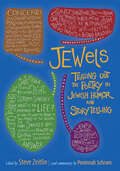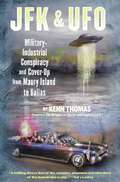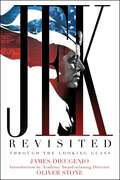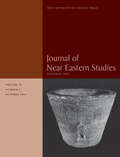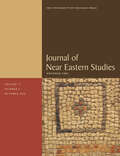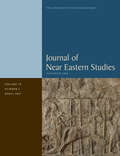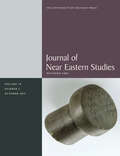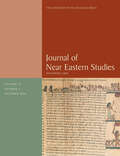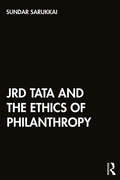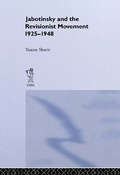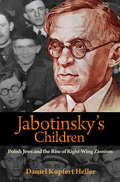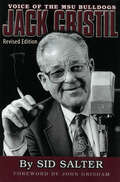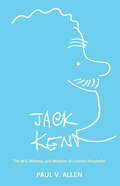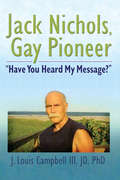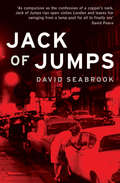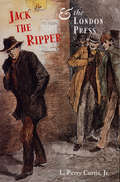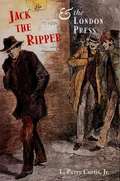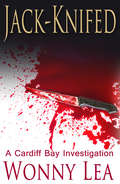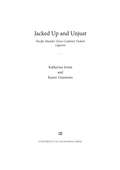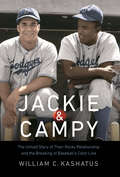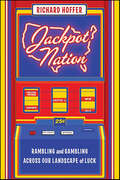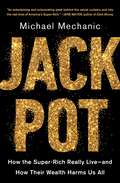- Table View
- List View
JEWels: Teasing Out the Poetry in Jewish Humor and Storytelling
by Peninnah SchramJEWels is the first of its kind: the living tradition of Jewish stories and jokes transformed into poems, recording and reflecting Jewish experience from ancient times through the present day. In this novel hybrid—jokes and stories boiled down to their essence in short poems—Jewish witticism is preserved side by side with evocative storytelling and deepened with running commentary and questions for discussion. Illuminated here are jewels from journeys, from the Old Country, from Torah, shaped by the Holocaust, in glimpses of Jewish American lives, in Jewish foods, in conversations with God, and on the meaning of life. Jewish comedians (Lenny Bruce, Jackie Mason) appear alongside writers and musicians (Elie Wiesel, Sholem Aleichem, Itzhak Perlman) and Hasidic rabbis (the Baal Shem Tov, Rabbi Nachman of Breslov), yet most of the tellers are ordinary Jews. In this cacophony of ongoing dialogue, storytellers, rabbis, poets, and scholars chime in with interpretations, quips, and related stories and life experiences. In JEWels each of us can see our own reflection.
JFK & UFO
by Kenn ThomasIn 1947 six flying saucers circled above a harbor boat in Puget Sound near Tacoma, Washington, one wobbling and spewing slag. The falling junk killed a dog and burned a boy's arm. His father, Harold Dahl, witnessed it all and brought his partner, Fred Crisman, down the next day to see yet another UFO. The Maury Island incident became the first UFO event of the modern era. In 1968 New Orleans district attorney Jim Garrison subpoenaed Fred Crisman as part of his investigation into the JFK assassination, which became the subject of Oliver Stone's 1992 movie JFK. Garrison believed that Crisman was the infamous grassy knoll shooter. He's also the central figure in the "Mystery Tramp" photo of the Dallas rail yard hobos. Illustrated with rare images, JFK & UFO interconnects the lingering mysteries of America's most notorious assassination and its weird ufological subculture. It examines the denizens of the bizarre, semi-spook underground reflecting a stranger and more true history than offered by the mainstream.
JFK Has Been Shot
by Charles A. Crenshaw Jens Hansen J. Gary ShawThe &“thrilling, dramatic, historic&” #1 New York Times bestseller by the Parkland Hospital surgeon who fought to save President John F. Kennedy (Robert K. Tanenbaum). On November 22, 1963, Dr. Charles Crenshaw, an accomplished surgeon, tried to save John F. Kennedy&’s life—and then days later, the life of the alleged assassin, Lee Harvey Oswald. His gripping, firsthand account contradicts the Warren Commission and years of public misperception to illuminate a chapter in American history long cloaked in conspiracy. Writing with eye-opening immediacy, Dr. Crenshaw takes readers into the emergency room to share the critical events at Parkland Hospital as he lived them. Now updated, his searing testimony punctures myths and shatters a cover-up of massive proportions. &“Hard-hitting, courageous, and correct in every respect.&”—Cyril Wecht, M.D., J.D. "Dr. Crenshaw offers his expert opinion with persuasive evidence. Read this page-turning account of the Kennedy assassination.&”—Robert K. Tanenbaum, Deputy Chief Counsel, Congressional Committee Investigation into the Assassination of President KennedyIncludes revealing photos Previously published as JFK Conspiracy of Silence
JFK Revisited: Through the Looking Glass
by James DiEugenioBased on Oliver Stone's documentary, JFK Revisited, read the transcripts and interviews that will change the way you think about the John F. Kennedy assassination.JFK Revisited: Through the Looking Glass contains the two working original screenplays for Oliver Stone&’s JFK Revisited; both the two-hour version, Through the Looking Glass, and the four-hour version, Destiny Betrayed. These films are the first documentaries to feature the work of the Assassination Records Review Board. The Assassination Records Review Board worked from 1994–98 releasing records that the government has classified in whole or in part on the assassination of President John F. Kennedy. They ended up releasing about two million pages or approximately sixty thousand documents. They also pursued an investigation into the autopsy and medical evidence in the JFK case. Although their releases and discoveries were quite important to the evidentiary record, they received very little exposure in the mainstream media. They also released documents relating to Kennedy&’s foreign policy in both Cuba and Vietnam. In the former case, these were plans by the Pentagon to create a pretext to invade Cuba. In the latter, documents proved Kennedy was implementing a withdrawal plan from Vietnam. This book is unprecedented. It contains a compendium of information originating from the widest range of authorities on the JFK case ever assembled. This includes luminaries from several fields: pathology, surgery, ballistics, criminal investigation, neurology, history, and journalism. Never before have people like forensic pathologist Cyril Wecht, criminalist Henry Lee, Professor James Galbraith, author David Talbot, journalist Jefferson Morley, intelligence analyst John Newman, Professor Robert Rakove, and more appeared in one book; never have this many illustrious authorities been interviewed about their views on the policies and the assassination of President John F. Kennedy. The book also includes important witness interviews with Dr. Donald Miller about his colleague Malcolm Perry, Jim Gochenaur of the Church Committee, and Edwin McGehee of both the House Select Committee on Assassinations and the Jim Garrison investigation. The combination of this newly released information plus expert interviews changed the database and calculus of the JFK case. The scripts are included in this book, which were the backbone for Oliver Stone's films. It also includes important excerpts from the many interviews which did not make it into the final cuts of the films. JFK Revisited will challenge everything you thought you know about the JFK assassination.
JNES vol 75 num 2
by The University of Chicago PressThis is volume 75 issue 2 of Journal of Near Eastern Studies. The Journal of Near Eastern Studies (JNES) is devoted to the study of the civilizations of the Near East from prehistory to the early modern period in 1922. JNES embraces a uniquely broad scope of time, place, and topic, including contributions from scholars of international reputation on topics in Assyriology, Egyptology, Hittitology, Hebrew Bible, and adjacent ancient studies, as well as a second area of emphasis in early, medieval, and early-modern Islamic studies. The disciplinary range of the journal runs from history and language to religion and literature to archaeology and art history. Every issue includes new scholarly work as well as a book review section, which provides a critical overview of new publications by emerging and established scholars.
JNES vol 76 num 1
by The University of Chicago PressThis is volume 76 issue 1 of Journal of Near Eastern Studies. The Journal of Near Eastern Studies (JNES) is devoted to the study of the civilizations of the Near East from prehistory to the early modern period in 1922. JNES embraces a uniquely broad scope of time, place, and topic, including contributions from scholars of international reputation on topics in Assyriology, Egyptology, Hittitology, Hebrew Bible, and adjacent ancient studies, as well as a second area of emphasis in early, medieval, and early-modern Islamic studies. The disciplinary range of the journal runs from history and language to religion and literature to archaeology and art history. Every issue includes new scholarly work as well as a book review section, which provides a critical overview of new publications by emerging and established scholars.
JNES vol 77 num 2
by The University of Chicago PressThis is volume 77 issue 2 of Journal of Near Eastern Studies. The Journal of Near Eastern Studies (JNES) is devoted to the study of the civilizations of the Near East from prehistory to the early modern period in 1922. JNES embraces a uniquely broad scope of time, place, and topic, including contributions from scholars of international reputation on topics in Assyriology, Egyptology, Hittitology, Hebrew Bible, and adjacent ancient studies, as well as a second area of emphasis in early, medieval, and early-modern Islamic studies. The disciplinary range of the journal runs from history and language to religion and literature to archaeology and art history. Every issue includes new scholarly work as well as a book review section, which provides a critical overview of new publications by emerging and established scholars.
JNES vol 78 num 1
by The University of Chicago PressThis is volume 78 issue 1 of Journal of Near Eastern Studies. The Journal of Near Eastern Studies (JNES) is devoted to the study of the civilizations of the Near East from prehistory to the early modern period in 1922. JNES embraces a uniquely broad scope of time, place, and topic, including contributions from scholars of international reputation on topics in Assyriology, Egyptology, Hittitology, Hebrew Bible, and adjacent ancient studies, as well as a second area of emphasis in early, medieval, and early-modern Islamic studies. The disciplinary range of the journal runs from history and language to religion and literature to archaeology and art history. Every issue includes new scholarly work as well as a book review section, which provides a critical overview of new publications by emerging and established scholars.
JNES vol 78 num 2
by The University of Chicago PressThis is volume 78 issue 2 of Journal of Near Eastern Studies. The Journal of Near Eastern Studies (JNES) is devoted to the study of the civilizations of the Near East from prehistory to the early modern period in 1922. JNES embraces a uniquely broad scope of time, place, and topic, including contributions from scholars of international reputation on topics in Assyriology, Egyptology, Hittitology, Hebrew Bible, and adjacent ancient studies, as well as a second area of emphasis in early, medieval, and early-modern Islamic studies. The disciplinary range of the journal runs from history and language to religion and literature to archaeology and art history. Every issue includes new scholarly work as well as a book review section, which provides a critical overview of new publications by emerging and established scholars.
JNES vol 79 num 2
by The University of Chicago PressThis is volume 79 issue 2 of Journal of Near Eastern Studies. The Journal of Near Eastern Studies (JNES) is devoted to the study of the civilizations of the Near East from prehistory to the early modern period in 1922. JNES embraces a uniquely broad scope of time, place, and topic, including contributions from scholars of international reputation on topics in Assyriology, Egyptology, Hittitology, Hebrew Bible, and adjacent ancient studies, as well as a second area of emphasis in early, medieval, and early-modern Islamic studies. The disciplinary range of the journal runs from history and language to religion and literature to archaeology and art history. Every issue includes new scholarly work as well as a book review section, which provides a critical overview of new publications by emerging and established scholars.
JRD Tata and the Ethics of Philanthropy
by Sundar SarukkaiThis book introduces readers to the ethics of philanthropy, particularly in the Indian context. Drawing on JRD Tata’s philosophy and approach to business, it shows how business and philanthropy were intrinsically related for him. JRD Tata was arguably one of the most influential businessmen in post-Independence India. He was instrumental in not only expanding the Tata businesses but was also known for his impact on the conduct of business as well as his support for various national projects including research and education. He introduced key labour laws in his factories, which later became the model for the Indian government. He was also part of government institutions such as Air India. By discussing ideas such as trusteeship, the notion of profit, the relation between public and private, and social welfare, the book offers an intellectual map of JRD’s thoughts and an original perspective on their significance for an ethics of philanthropy in general. It provides new insights into the nature of ethical problems in the Indian context as well as ways to negotiate with them based on JRD’s work and reflections. It further creates a more meaningful understanding of Corporate Social Responsibility in the present global economy. Lucid and comprehensive, this book will be useful to scholars, researchers and faculty in departments of management and business studies, social work, sociology, economics and philosophy, as well as across social sciences. It will be of great interest to philanthropy organisations, non-governmental organisations, business schools, industry bodies, corporates, and those in leadership and management.
Jabotinsky and the Revisionist Movement 1925-1948
by Yaacov ShavitFirst published in 1988. The focus of this title, the nature and character of the Israeli political Right, gained intensive interest immediately after the Israeli elections of 1977. The author discusses this shift of political power from the Left to the Right as a profound political upheaval and discusses this alongside the prior Labour hegemony of the Yishuv. This book is separated into four parts: The territory and organisation of the right; The intellectual foundation of the right; Ideology, programme and political methods and Contradictory images.
Jabotinsky's Children: Polish Jews and the Rise of Right-Wing Zionism
by Daniel Kupfert HellerHow interwar Poland and its Jewish youth were instrumental in shaping the ideology of right-wing ZionismBy the late 1930s, as many as fifty thousand Polish Jews belonged to Betar, a youth movement known for its support of Vladimir Jabotinsky, the founder of right-wing Zionism. Poland was not only home to Jabotinsky’s largest following. The country also served as an inspiration and incubator for the development of right-wing Zionist ideas. Jabotinsky’s Children draws on a wealth of rare archival material to uncover how the young people in Betar were instrumental in shaping right-wing Zionist attitudes about the roles that authoritarianism and military force could play in the quest to build and maintain a Jewish state.Recovering the voices of ordinary Betar members through their letters, diaries, and autobiographies, Jabotinsky’s Children paints a vivid portrait of young Polish Jews and their turbulent lives on the eve of the Holocaust. Rather than define Jabotinsky as a firebrand fascist or steadfast democrat, the book instead reveals how he deliberately delivered multiple and contradictory messages to his young followers, leaving it to them to interpret him as they saw fit. Tracing Betar’s surprising relationship with interwar Poland’s authoritarian government, Jabotinsky’s Children overturns popular misconceptions about Polish-Jewish relations between the two world wars and captures the fervent efforts of Poland’s Jewish youth to determine, on their own terms, who they were, where they belonged, and what their future held in store.Shedding critical light on a vital yet neglected chapter in the history of Zionism, Jabotinsky’s Children provides invaluable perspective on the origins of right-wing Zionist beliefs and their enduring allure in Israel today.
Jack Cristil: Voice of the MSU Bulldogs, Revised Edition
by Sid SalterJack Cristil (1925-2014) was a Southeastern Conference icon and the Voice of Bulldog athletics for more than five decades. In this biography, Cristil's remarkable life and career is shared with all Bulldog fans. Authored by Mississippi journalist Sid Salter with a foreword by distinguished Mississippi State University alum John Grisham, the book originally sold over 10,000 copies and raised over $170,000 for the Jacob S. "Jack" Cristil Scholarship in Journalism at MSU.With a fifty-eight-year association with MSU, Cristil was the second-longest tenured college radio play-by-play announcer in the nation at the time of his 2011 retirement. During his legendary career as the Voice of the Bulldogs, Cristil called 636 football games since 1953. That's roughly 60 percent of all the football games played in school history. He was in his 54th season as the men's basketball play-by-play voice, having described the action of almost 55 percent of all the men's basketball games. In all, Cristil shared with Bulldog fans across the Magnolia State and around the world more than 1,500 collegiate contests. Central to Cristil's inspiring story was his upbringing in Memphis as the son of first-generation Russian-Jewish immigrants. This paperback edition is updated with new material covering Cristil's death and memorial service, with additional post-retirement and memorial photos.
Jack Kent: The Wit, Whimsy, and Wisdom of a Comic Storyteller
by Paul V. AllenJack Kent (1920–1985) had two distinct and successful careers: newspaper cartoonist and author of children’s books. For each of these he drew upon different aspects of his personality and life experiences. From 1950 to 1965 he wrote and drew King Aroo, a nationally syndicated comic strip beloved by fans for its combination of absurdity, fantasy, wordplay, and wit. The strip’s DNA was comprised of things Kent loved—fairytales, nursery rhymes, vaudeville, Krazy Kat, foreign languages, and puns. In 1968, he published his first children’s book, Just Only John, and began a career in kids’ books that would result in over sixty published works, among them such classics as The Fat Cat and There’s No Such Thing as a Dragon. Kent’s stories for children were funny but often arose from the dark parts of his life—an itinerant childhood, an unfinished education, two harrowing tours of duty in World War II, and a persistent lack of confidence—and tackled such themes as rejection, isolation, self-doubt, and the desire for transformation.Jack Kent: The Wit, Whimsy, and Wisdom of a Comic Storyteller illuminates how Kent’s life experiences informed his art and his storytelling in both King Aroo and his children’s books. Paul V. Allen draws from archival research, brand-new interviews, and in-depth examinations of Kent’s work. Also included are many King Aroo comic strips that have never been reprinted in book form.
Jack Nichols, Gay Pioneer: "Have You Heard My Message?"
by J. Louis Campbell IIIOne of the founders of the gay and lesbian liberation movement, Jack Nichols was a warrior for gay equality. Recounting his life and work, Jack Nichols, Gay Pioneer: “Have You Heard My Message?” skillfully weaves the story of a man, a movement, and a moment that shaped gay and lesbian history. This powerful biography captures the wisdom, passion, and spirit of a prolific activist and inspirational human being who refused to be silent in a society that considered homosexuality to be sinful and criminal. As a journalist, activist, and editor of the first gay weekly newspaper in the United States, Jack Nichols left a legacy of gay rights, gay pride, and tremendous courage. Covering episodes before and after Stonewall, during the AIDS epidemic, and beyond, Jack Nichols, Gay Pioneer charts the life of this pivotal figure from his childhood in the suburbs of Washington, DC, to his final impassioned days in a Florida cancer treatment center in 2005. This book also explores Nichols’ family history and its unique influence on his activist tendencies, as well as his revolutionary relationship with Lige Clark and their status as “the most famous homosexuals in America.” Thoughtful and moving, Jack Nichols: Gay Pioneer also includes the ideas Nichols used to bring the movement to critical mass, and the sources that were influential to his work. Some of the topics detailed in this book are the early influence of Burns and Whitman on the homosexual movement, the integration of androgyny and anarchism into his activist philosophy, his attack on the psychiatric establishment’s theory of homosexuality as a “sickness”, and his work and vision in men’s liberation. Jack Nichols, Gay Pioneer: “Have You Heard My Message?” offers a compelling look at the man and the movement, as well as a wealth of hard-to-find summaries on underground gay journalism, detailed references, personal photographs, and a complete bibliography of Nichols’s major writings. This book is an indispensable resource for anyone interested in the history and future of LGBT movements, as well as students, educators, and researchers seeking a comprehensive and thorough treatment of this revolutionary figure.
Jack of Jumps
by David SeabrookA dark and deep dive into the &“Jack the Stripper&” murders that &“rips open sixties London and leaves her swinging from a lamp-post for all to finally see&” (David Peace, author of the Red Riding Quartet). Between 1959 and 1965, eight prostitutes were murdered in West London by a serial killer. The killer&’s motive and identity were the subject of endless speculation by the media, who dubbed him &“Jack the Stripper.&” Links to the Profumo scandal, boxer Freddie Mills and the notorious Kray twins were rumored. By the time the body of the eighth victim was found in February 1965, a massive police operation was underway to catch the killer. The whole country waited to see what would happen next. The police had staked everything on the murderer striking again. But he didn&’t . . . David Seabrook, the author of All the Devils Are Here, interviewed surviving police officers, witnesses and associates of the victims and examined the evidence, the rumors and the half-truths. He reconstructs every detail of the investigation and recreates the dark, brutal world of prostitutes and pimps in 1960s West London. He questions the theory that the police&’s prime suspect was Jack the Stripper and confronts the disturbing possibility that the killer is still at large. &“Seabrook taps away at the darker recesses of the metropolitan mind, relishing the fact that his subject is so heroically unglamorous.&”—The Guardian &“The genius of this one is how it teases horror from the banal . . . A terrifying portrait of the dark side of Notting Hill and Shepherd&’s Bush at the time, with its stew of sex, drugs, immigration, violence, and a residual white working-class.&”—The Telegraph
Jack the Ripper & the London Press
by L. Perry Curtis Jr.&“Breaks new ground in its examination of the role of newspaper reporting during the police hunt for the first notorious serial killer.&”—Reviews in History Press coverage of the 1888 mutilation murders attributed to Jack the Ripper was of necessity filled with gaps and silences, for the killer remained unknown and Victorian journalists had little experience reporting serial murders and sex crimes. This engrossing book examines how fourteen London newspapers—dailies and weeklies, highbrow and lowbrow—presented the Ripper news, in the process revealing much about the social, political, and sexual anxieties of late Victorian Britain and the role of journalists in reinforcing social norms. L. Perry Curtis surveys the mass newspaper culture of the era, delving into the nature of sensationalism and the conventions of domestic murder news. Analyzing the fourteen newspapers—two of which emanated from the East End, where the murders took place—he shows how journalists played on the fears of readers about law and order by dwelling on lethal violence rather than sex, offering gruesome details about knife injuries but often withholding some of the more intimate details of the pelvic mutilations. He also considers how the Ripper news affected public perceptions of social conditions in Whitechapel. &“The apparently motiveless violence of the Whitechapel killings denied journalists a structure, and it is the resulting creativity in news reporting that L Perry Curtis Jr describes. His impressive book makes a genuine contribution to 19th-century history in a way that books addressing the banal question of the identity of the Ripper do not.&”—The Guardian
Jack the Ripper and the London Press
by L. Perry CurtisPerry Curtis reveals mutilation murders by Jack the Ripper as told by different London newspapers.
Jack-Knifed: The DCI Phelps Series (DCI Phelps #1)
by Wonny LeaA twisty and unputdownable detective crime novel perfect for fans of Agatha Christie, Dorothy L. Sayers, Faith Martin, J.R. Ellis, LJ Ross, Miss Marple and Midsummer Murders!'Jack-Knifed' is the first novel featuring DCI Martin Phelps and his team, based in the world-famous and vibrant Cardiff Bay.Mark Wilson, a decent, well-liked gay man, lives alone in a beautiful house in Cardiff. One Saturday evening, his closest friends go to his house for an evening of drinks and catching-up.Finding no answer, the concerned friends break in - to a horrific murder scene. For Mark Wilson has been brutally, sadistically murdered in his own home.As DCI Phelps investigates, Mark's traumatic early life is revealed. Was his killer someone from his past? Was his sexuality a motive? What about his violent, homophobic father - a man who has already killed more than once ...Meanwhile, Mark's estranged sister Amy broods on the hatred she has for her brother, blaming him for turning their father into a killer. As she sinks further in to the depths of drug addiction, who's to say what her next move will be?As the body count rises, Phelps and his sergeant, Matt Pryor, soon realise they are on the trail of a serial killer ..._________________________________________Praise for Wonny Lea's INSANELY GRIPPING detective series:'An excellent, well written book that held your attention from page one to the final page. Please read this book' ***** Amazon review'Very enjoyable read with twists and turns and surprises along the way and would recommend to anyone who likes crime/thrillers' ***** Amazon review'This book was great read. The story was well written and the plot excellently thought out' ***** Amazon review'Found it hard to put this story down. The characters seem so real, and the plot keeps twisting and turning... there is an amazing twist towards the end which was totally unexpected' ***** Amazon review'I wasn't expecting the ending but I won't spoil it, just to say it was an excellent read' ***** Amazon review
Jack-Knifed: The DCI Phelps Series (Dci Phelps Ser. #1)
by Wonny LeaA twisty and unputdownable detective crime novel perfect for fans of Agatha Christie, Dorothy L. Sayers, Faith Martin, J.R. Ellis, LJ Ross, Miss Marple and Midsummer Murders!'Jack-Knifed' is the first novel featuring DCI Martin Phelps and his team, based in the world-famous and vibrant Cardiff Bay.Mark Wilson, a decent, well-liked gay man, lives alone in a beautiful house in Cardiff. One Saturday evening, his closest friends go to his house for an evening of drinks and catching-up.Finding no answer, the concerned friends break in - to a horrific murder scene. For Mark Wilson has been brutally, sadistically murdered in his own home.As DCI Phelps investigates, Mark's traumatic early life is revealed. Was his killer someone from his past? Was his sexuality a motive? What about his violent, homophobic father - a man who has already killed more than once ...Meanwhile, Mark's estranged sister Amy broods on the hatred she has for her brother, blaming him for turning their father into a killer. As she sinks further in to the depths of drug addiction, who's to say what her next move will be?As the body count rises, Phelps and his sergeant, Matt Pryor, soon realise they are on the trail of a serial killer ..._________________________________________Praise for Wonny Lea's INSANELY GRIPPINGdetective series:'An excellent, well written book that held your attention from page one to the final page. Please read this book' ***** Amazon review'Very enjoyable read with twists and turns and surprises along the way and would recommend to anyone who likes crime/thrillers' ***** Amazon review'This book was great read. The story was well written and the plot excellently thought out' ***** Amazon review'Found it hard to put this story down. The characters seem so real, and the plot keeps twisting and turning... there is an amazing twist towards the end which was totally unexpected' ***** Amazon review'I wasn't expecting the ending but I won't spoil it, just to say it was an excellent read' ***** Amazon review
Jacked Up and Unjust: Pacific Islander Teens Confront Violent Legacies
by Katherine Irwin Karen UmemotoIn the context of two hundred years of American colonial control in the Pacific, Katherine Irwin and Karen Umemoto shed light on the experiences of today's inner city and rural girls and boys in Hawai'i who face racism, sexism, poverty, and political neglect. Basing their book on nine years of ethnographic research, the authors highlight how legacies of injustice endure, prompting teens to fight for dignity and the chance to thrive in America, a nation that the youth describe as inherently "jacked up"--rigged--and "unjust." While the story begins with the youth battling multiple contingencies, it ends on a hopeful note with many of the teens overcoming numerous hardships, often with the guidance of steadfast, caring adults.
Jackie and Campy: The Untold Story of Their Rocky Relationship and the Breaking of Baseball's Color Line
by William C. KashatusAs star players for the 1955 World Champion Brooklyn Dodgers, and prior to that as the first black players to be candidates to break professional baseball’s color barrier, Jackie Robinson and Roy Campanella would seem to be natural allies. But the two men were divided by a rivalry going far beyond the personality differences and petty jealousies of competitive teammates. Behind the bitterness were deep and differing beliefs about the fight for civil rights. Robinson, the more aggressive and intense of the two, thought Jim Crow should be attacked head-on; Campanella, more passive and easygoing, believed that ability, not militancy, was the key to racial equality. Drawing on interviews with former players such as Monte Irvin, Hank Aaron, Carl Erskine, and Don Zimmer, Jackie and Campy offers a closer look at these two players and their place in a historical movement torn between active defiance and passive resistance. William C. Kashatus deepens our understanding of these two baseball icons and civil rights pioneers and provides a clearer picture of their time and our own.
Jackpot Nation: Rambling and Gambling Across Our Landscape of Luck
by Richard HofferIs this a great country or what?You can bet on the turn of the card or a roll of the dice, but also on the NFL, the NCAA, and which Olsen twin marries first. We bet $80 billion a year, the amount growing wildly as more and more people gain access to this huge American wheel of fortune. No longer quarantined in Las Vegas, gambling has become as local and convenient as our neighborhood cineplex. If there's not a casino around the corner, there's one on your laptop computer.In Jackpot Nation, Richard Hoffer takes us on a headlong tour, alternately horrifying and hilarious, across our landscape of luck. Whether he's trying to win a side of bacon in a Minnesota bar, hustling a paper sack filled with $100,000 in cash across Las Vegas parking lots, poring over expansion plans with a tribal chief in California, or visiting the New York prison cell of a retired bus salesman with a poor understanding of three-game parlays, Hoffer explores with wit and heart our national inclination—a cultural predisposition, even—to take a chance.
Jackpot: How the Super-Rich Really Live—and How Their Wealth Harms Us All
by Michael MechanicA senior editor at Mother Jones dives into the lives of the extremely rich, showing the fascinating, otherworldly realm they inhabit—and the insidious ways this realm harms us all.Have you ever fantasized about being ridiculously wealthy? Probably. Striking it rich is among the most resilient of American fantasies, surviving war and peace, expansions and recessions, economic meltdowns and global pandemics. We dream of the jackpot, the big exit, the life-altering payday, in whatever form that takes. (Americans spent $81 billion on lottery tickets in 2019, more than the GDPs of most nations.) We would escape &“essential&” day jobs and cramped living spaces, bury our debts, buy that sweet spread, and bail out struggling friends and relations. But rarely do we follow the fantasy to its conclusion—to ponder the social, psychological, and societal downsides of great affluence and the fact that so few possess it. What is it actually like to be blessed with riches in an era of plagues, political rancor, and near-Dickensian economic differences? How mind-boggling are the opportunities and access, how problematic the downsides? Does the experience differ depending on whether the money is earned or unearned, where it comes from, and whether you are male or female, white or black? Finally, how does our collective lust for affluence, and our stubborn belief in social mobility, explain how we got to the point where forty percent of Americans have literally no wealth at all? These are all questions that Jackpot sets out to explore. The result of deep reporting and dozens of interviews with fortunate citizens—company founders and executives, superstar coders, investors, inheritors, lottery winners, lobbyists, lawmakers, academics, sports agents, wealth and philanthropy professionals, concierges, luxury realtors, Bentley dealers, and even a woman who trains billionaires&’ nannies in physical combat, Jackpot is a compassionate, character-rich, perversely humorous, and ultimately troubling journey into the American wealth fantasy and where it has taken us.
